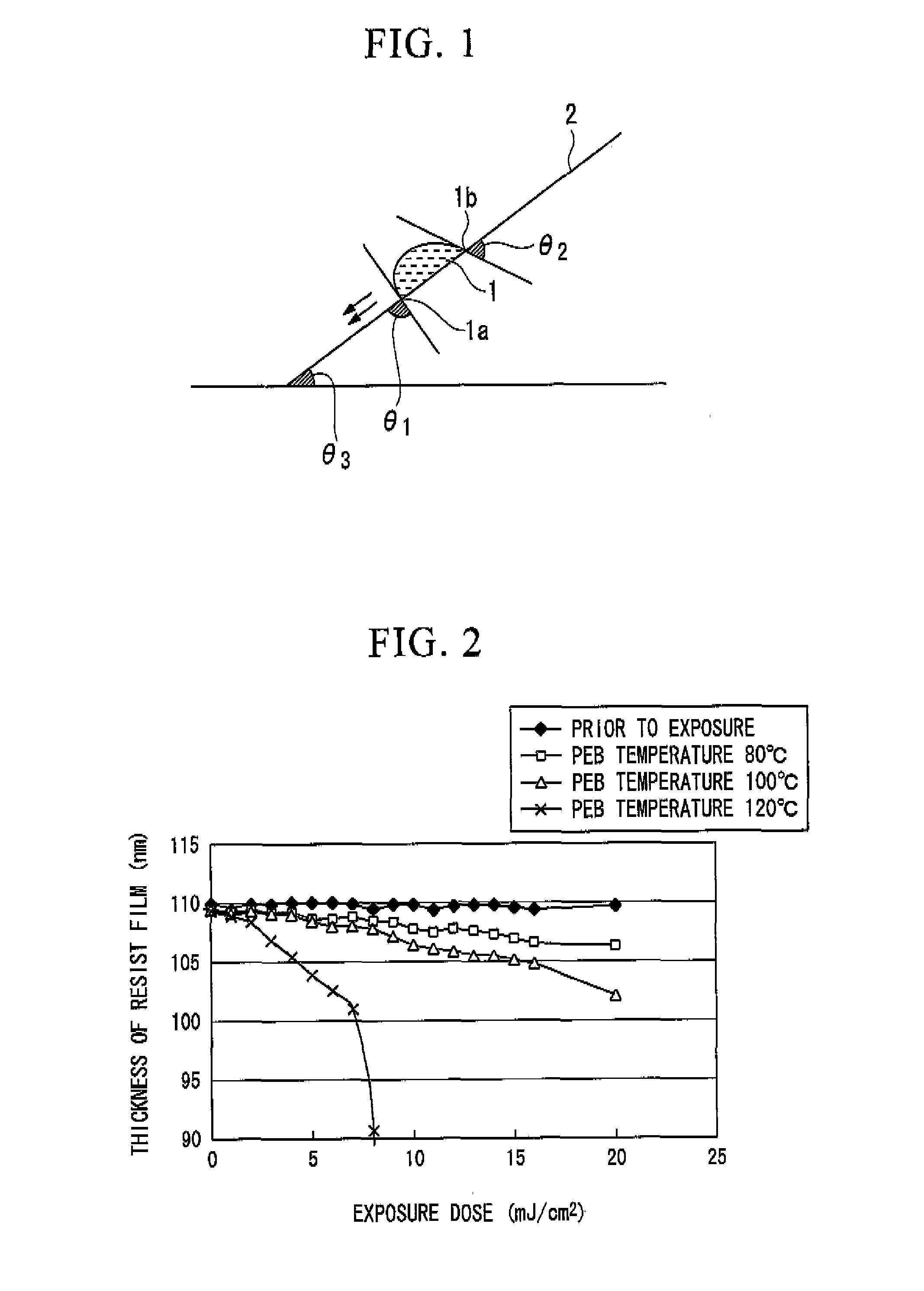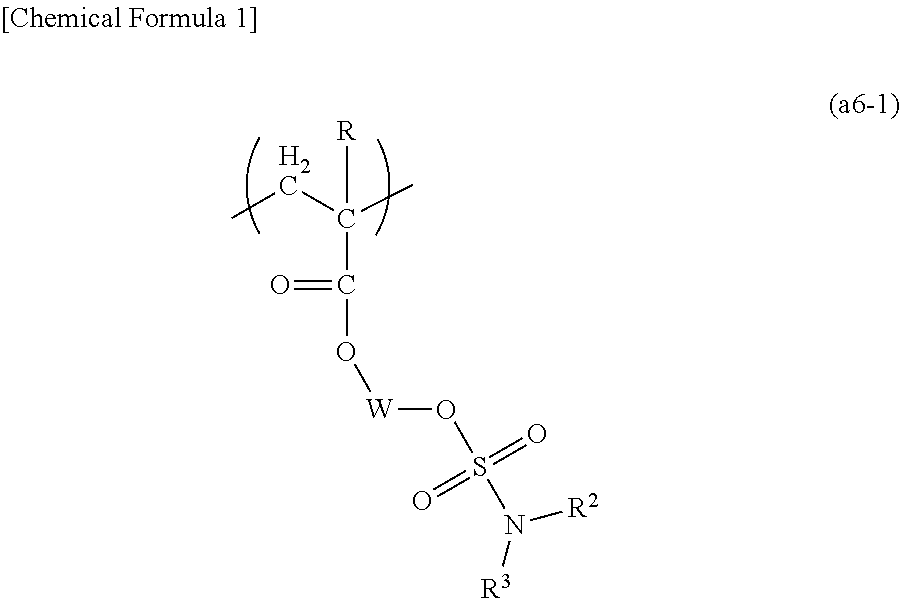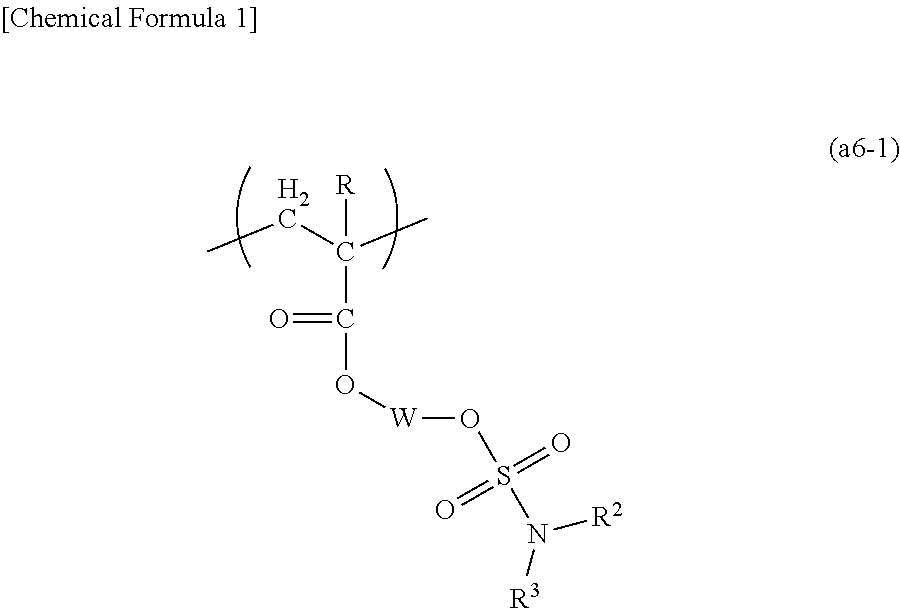Positive resist composition and method of forming resist pattern
a composition and resist technology, applied in the field of positive resist composition and a method of forming a resist pattern, can solve the problems of adversely affecting the lithography properties, speed becomes low, and productivity is adversely affected
- Summary
- Abstract
- Description
- Claims
- Application Information
AI Technical Summary
Benefits of technology
Problems solved by technology
Method used
Image
Examples
synthesis example 1
Monomer Synthesis Example 1
Synthesis of Compound (11)
[0747]Synthesis of 3-sulfamoyloxyadamantyl methacrylate
[0748]A 5-liter four-necked flask equipped with a thermometer, a dropping funnel and a stirrer was purged with nitrogen, and 980 g of heptane and 334 g (2.4 mol) of chlorosulfonyl isocyanate were added thereto using the dropping funnel. The internal temperature was cooled to 5° C., and 110 g (2.4 mol) of formic acid was added dropwise from the dropping funnel at a rate that maintained the temperature inside the flask at 5 to 8° C. Following completion of the dropwise addition, the internal temperature was raised to 20° C., and the mixture was stirred for 10 hours. To the resulting mixed solution was added a solution containing 186.7 g (0.79 mol) of 3-hydroxyadamantyl methacrylate, 525 g of N-methylpyrrolidone, 2.1 g of 4-methoxyphenol and 2.1 g of phenothiazine, with the addition performed via the dropping funnel at a rate that maintained the temperature inside the flask at a ...
synthesis example 2
Monomer Synthesis Example 2
Synthesis of Compound (21)
[0752](i) Synthesis of Compound (21)-2
[0753]61 g (600 mmol) of triethylamine and 64 g (418 mmol) of methyl bromoacetate were added to 300 ml of a THF solution containing 30 g (348 mmol) of methacrylic acid in a nitrogen atmosphere at 0° C., and the temperature was elevated to room temperature, followed by stirring for 3 hours. After conducting thin-layer chromatography (TLC) to confirm that the raw materials had dissipated, the reaction solution was subjected to distillation under reduced pressure to remove the solvent. Then, water was added to the resultant, and extraction was conducted with ethyl acetate three times. The resulting organic phase was washed with water twice, and then subjected to distillation under reduced pressure to remove the solvent, thereby obtaining 47 g of a compound (21)-1 in the form of a colorless liquid (yield: 85%).
[0754]Subsequently, 700 ml of a THF solution containing 30 g (190 mmol) of the compound ...
polymer synthesis example 1
Synthesis of Polymeric Compound (1)
[0765]In a three-necked flask equipped with a thermometer and a reflux tube, 5.00 g (22.12 mmol) of a compound (21), 3.63 g (16,22 mmol) of a compound (25) and 3.41 g (10.82 mmol) of a compound (11) were dissolved in 28.09 g of methyl ethyl ketone (MEK) to obtain a solution. Then, 2.46 mmol of dimethyl 2,2′-azobis(isobutyrate) (V-601) as a polymerization initiator was added and dissolved in the resulting solution.
[0766]The resulting reaction solution was heated at 80° C. while stirring for 6 hours, and then cooled to room temperature.
[0767]The obtained reaction polymer solution was dropwise added to an excess amount of n-heptane, and an operation to deposit a polymer was conducted. Thereafter, the precipitated white powder was separated by filtration, followed by washing with n-heptane and methanol and drying, thereby obtaining 8.4 g of a polymeric compound (1) as an objective compound.
[0768]With respect to the polymeric compound (1), the weight av...
PUM
 Login to View More
Login to View More Abstract
Description
Claims
Application Information
 Login to View More
Login to View More - R&D
- Intellectual Property
- Life Sciences
- Materials
- Tech Scout
- Unparalleled Data Quality
- Higher Quality Content
- 60% Fewer Hallucinations
Browse by: Latest US Patents, China's latest patents, Technical Efficacy Thesaurus, Application Domain, Technology Topic, Popular Technical Reports.
© 2025 PatSnap. All rights reserved.Legal|Privacy policy|Modern Slavery Act Transparency Statement|Sitemap|About US| Contact US: help@patsnap.com



